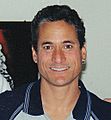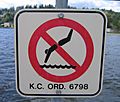Synchronized diving facts for kids
Synchronized diving (often called synchro diving) is an exciting sport. In it, two divers jump at the same time as a team. They dive from either a three-meter springboard or a ten-meter platform.
This sport is a type of diving. It became part of the Olympic Games at the 2000 Sydney Olympics. Competitions usually have five or six rounds. In the first two rounds, divers perform basic dives. Then, they do more complex, freestyle dives in the later rounds.
Judges give scores to decide the winners. There are two kinds of judges. Technical judges look at how well each diver performs their dive. Synchro judges check how perfectly the two divers match each other.
Contents
History of Synchronized Diving
Synchronized diving first appeared internationally at the 1995 FINA World Cup. This was a big step for the sport.
In 1999, four synchronized diving events were added to the Olympic program. This decision was made at a meeting in Lausanne. The sport then made its Olympic debut at the 2000 Sydney Games. Both men and women competed in three-meter springboard and ten-meter platform events.
Types of Dives
Divers perform many different types of dives. These dives are grouped based on how the diver starts and moves.
Dive Groups
There are six main groups of dives. The first four groups describe the direction a diver spins.
- Forward group: The diver faces the front of the board. They jump forward into the water.
- Backward group: Divers start with their back to the water on the end of the board. They then jump backward.
- Reverse group: The diver faces the front of the board. They then rotate back towards the board.
- Inward group: Divers start with their back to the water. They then rotate forward towards the board.
- Twisting group: These dives include any dive where the diver twists. This group does not include armstand dives.
- Armstand group: Divers begin by balancing on their hands (a handstand) on the platform. Then they perform their dive.
Body Positions
Divers can hold one of four main body positions during a dive.
- Pike: The diver keeps their legs straight. Their body bends at the waist. Arm positions can change depending on the dive.
- Tuck: The diver bends at the waist and knees. Their thighs are pulled close to their chest. Heels stay near the bottom, and feet are kept together.
- Straight: The diver keeps their body straight. There is no bend at the waist or knees. Arm positions can vary.
- Free: This position is used for twisting dives. It can be any of the above three positions, or a mix of them.
Scoring and Judging
Synchronized diving needs many judges to score the dives fairly.
Scoring
For individual diving, seven judges are needed. But for synchronized diving, 11 judges score the event. Three judges score the first diver's performance. Three other judges score the second diver's performance. The remaining five judges focus only on how well the two divers match each other.
Each judge gives a score between 0 and 10 points. They can use half-point increments (like 8.5 or 9.0).
- 10: Excellent
- 8.5-9.5: Very good
- 7-8: Good
- 5-6.5: Satisfactory
- 2.5-4.5: Deficient
- 0.5-2: Unsatisfactory
- 0: Completely failed
Judging
Judges look at several parts of a dive to give a total score.
- Approach: This is how the diver walks to the end of the board. It should be smooth and strong, with good form.
- Takeoff: This is the jump from the board. Divers must show control and balance. The angle and distance from the board are important.
- Elevation: This is how high the diver jumps. A higher jump helps divers perform their movements smoothly and accurately.
- Execution: This is how well the dive is performed. Judges look for proper skills, form, and grace.
- Entry: This is how the diver enters the water. It is the last thing judges see. The entry should be straight up and down, with very little splash.
Images for kids
-
A man dives into the Great South Bay of Long Island.
-
Swedish high diver Arvid Spångberg at the 1908 Summer Olympics from the fourth Olympiad.
-
1984 and 1988 Olympic gold medal diver Greg Louganis
-
A mixed-sex pair, participating in FINA World Championships of Synchronized swimming, waves to the crowd before diving into water.
-
A sign prohibiting diving at a beach in Kirkland, Washington
-
Tomb of the Diver, Paestum, Italy, a Greek fresco dated 470 BC
-
The University of Houston's CRWC Natatorium is home to the United States' largest collegiate swimming pool
-
A man diving into Lake Michigan














